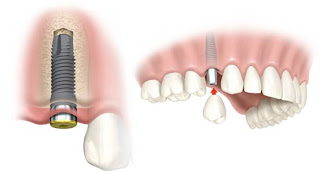
Dental restorations are procedures to repair a damaged or decayed tooth. The most common type of restorative dentistry is a filling, which may be amalgam (ver), composite resin (white) or other materials. Crowns may be used when a filling will not be enough to strengthen the tooth, such as after root canal treatment or apicoectomy. Inlays and onlays are similar to crowns.
Dental restorations are used to restore damaged or decayed teeth. They can frequently save teeth that would otherwise need to be extracted. Restorations include fillings, inlays and onlays, veneers, crowns, implants, bridges, and dentures. Dental restorations can be described as direct and indirect restorations. Some restorations require multiple visits to the dentist (e.g., crowns, bridges). Restorations can be made from a number of different materials, including amalgam, composite resin, ionomers, metal alloys, porcelain and porcelain fused to metal.
WhY sHoUld A DaMaGeD Or DeCAyED ToOtH bE ResTOrED???
- A tooth is repaired to protect the part of the tooth that has become exposed by the decay or injury.
- It can prevent the loss of a tooth, since decay may spread and destroy the tooth.
- Restoration permits normal eating and chewing.
- Restored teeth should reinstate, or improve upon, the appearance of teeth and the face.
What are the available dental restoration???

A bridge is a device that replaces missing teeth with artificial teeth that are anchored to adjacent teeth or implants. Also called a partial denture, a bridge may be permanently attached (fixed) or removable and may last five to seven years or longer.
There are numerous types of bridges available, which can be made from various materials. In a traditional bridge, the artificial teeth, or pontics, are attached to natural abutment teeth located on either side of the gap.
A bridge is a type of indirect restoration. This means that it will require two or more visits to the dental office: one to prepare the abutment teeth and make impressions and another to fit and adjust the bridge and secure it into place.
An implant is an anchor for a prosthetic tooth or teeth (e.g., crown, bridge, denture) that is surgically placed in the jaw. It becomes fused with the jawbone as the bone heals around it. Implants are most commonly made of titanium, a special type of metal that bone fuses to and does not reject as a foreign body.
Implants are used to replace missing or lost teeth. A missing tooth can affect the jaw and lead to bone loss.People with missing teeth may also have difficulty chewing or be dissatisfied with their appearance.
Inlays and onlays are dental restorations used by a select number of dentist. In certain cases, inlays and onlays are a conservative alternative to full coverage dental crowns. Also known as indirect fillings, inlays and onlays offer a well-fitting, stronger, longer lasting reparative solution to tooth decay or similar damage. These restorations are beneficial from both an esthetic and functional point of view.
Inlays and onlays can often be used in place of traditional dental fillings to treat tooth decay or similar structural damage.
Complete dentures are used to replace missing teeth for people with no remaining teeth. Dentures may also be used for people who have lost several teeth. It is very important to replace missing teeth. The ill effects of not doing so can be a shift in remaining teeth, an inability to bite and chew properly, as well as a sagging facial appearance, which makes one appear older than they are.
Dental crowns, also known as “caps,” preserve the functionality of damaged teeth. Crowns may be used to protect a cracked tooth, restore functionality of a tooth with excessive decay, or replace a pre-existing crown. The purpose of a dental crown is to encase a needy tooth with a custom-designed material. Dentists today have a variety of conservative treatment options through which to restore teeth. If possible, these options should be explored and discussed before selecting the full coverage crown.





No comments:
Post a Comment